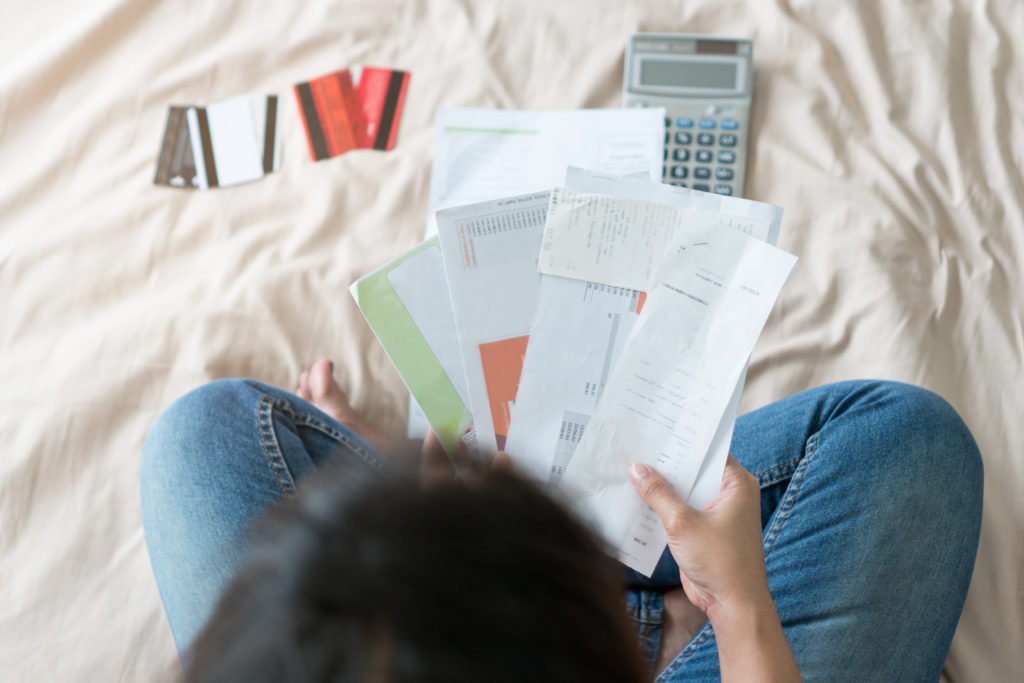
Managing your monthly budget and balancing getting out of debt at the same time can become tricky and overwhelming, especially when you’re living paycheck to paycheck. The good news is that there are several ways to shave off your debt while still paying your bills, even if you’re in this situation. In this article, we’ll share some helpful tips for paying off debt, and how to help you stop living paycheck to paycheck.
What Does Living Paycheck to Paycheck Mean?
Living paycheck to paycheck is when you make just enough money to cover the bills, or at least the bills plus the minimum required debt payments, as you wait for your next paycheck.

How Many Americans are Living Paycheck to Paycheck?
The living paycheck to paycheck statistics are overwhelmingly high in the U.S. According to a 2023 survey by Payroll.org, 78% of Americans now live paycheck to paycheck, marking a 6% increase from 2022.* This means that over three-quarters of Americans struggle to save or invest after covering their monthly expenses. It’s very important to break this cycle so that your paycheck isn’t depleted as soon as you get it. Sure, this may seem easier said than done, but that’s why we’ve put together a plan of attack for you below.
How to Stop Living Paycheck to Paycheck and Pay Off Your Debt
Consider these budgeting tips for living paycheck to paycheck to help you pay off your debt fast.
Create a Zero Sum Budget
One of the most important steps you can take in managing your money is monitoring where it goes. This can be done by creating a budget. There are several free budgeting apps for living paycheck to paycheck such as Empower Personal Dashboard™ and Honeydue.*
If you don’t want to use an app, begin by listing your expenses and debts. To achieve zero sum budgeting, you’ll need to leave no penny unused, hence the term “zero sum”. Separate your income by expenses, debts, and savings. If there isn’t enough money to cover expenses and debts, try to cut down your expenses by removing extras like entertainment. It could be more important to focus on reducing debt and investing money whenever possible.
For more helpful tips on drafting your own budget, check out our guide for how to build a budget in 2024.

Cut Unnecessary Spending
Cutting down expenses can be a challenging hurdle. However, there are many ways to lessen your spending. It may help to categorize your expenses first to see what categories are using up most of your funds. This will help lead you to where you need to focus so you can trim down your expenses.
Consider these suggestions:
- If household items that don’t expire are on sale, purchase in bulk and use them over time.
- Search for coupons for anything you purchase.
- Cook at home and pack your own lunches instead of eating out.
- Get rid of subscription services or call your providers to see if lower rates are available for essentials.
- Make your own coffee rather than buying it each day.
- If possible, get rid of your car or drive less, to save on gas. Alternatively, you can choose alternative modes of transportation such as public transportation, walking, biking, etc.
Prioritize Getting Out of Debt
Did you know that America’s household debt is currently at an all-time high? As of 2024, the total household debt in the U.S. is at $17.3 trillion dollars.* By adding some of these recommendations into your debt repayment plan even while on a tight budget, you can help to chip away at this figure.
Paying the minimum payment seems enticing because it’s lower than your balance, but that’s the hook that can cost you more money in the long run. By making only the minimum payments on your debts, you typically won’t reduce the amount you owe by much. This is because most of your minimum payment often goes towards paying interest. Each month, this can result in adding on more debt, creating a situation where you don’t have enough money to pay existing debts. Therefore, you keep accumulating more debt.
To avoid this, you may consider paying over the minimum amount. You may not be able to do this for every bill you owe, but you can start by choosing one and paying the minimum amount on your other bills in the meantime.
There are a few methods for getting out of debt, as we’ll get into below. But before you choose your preferred method, consider running a free credit report so you can itemize all your debt.*
Debt Payoff Strategies
The Debt Avalanche Method (or ladder method) focuses on paying off your highest interest rate account first. Then, you move down to the next “rung of the ladder” and cover the payments to the account with the second highest rate. Continue this process until you’ve zeroed out your funds. This option can help you save money in the long run because you’re eliminating your highest interest debt first.
Alternatively, you can use the Debt Snowball Method. This works the opposite way, like a snowball that starts small, rolls down a hill, and collects more snow (and momentum) along the way. Here, you begin with the smallest debt and work on up. While this option is less of a financial approach as you may pay more in interest over time, it’s more focused on the psychological effects of accomplishing the goal and gaining momentum to stay on track.
Lastly, consider using a debt payoff calculator to help you estimate how much you’ll have to repay over time.*
Only you know what method will work best for you. Either way, you’ll have a solid strategy to get rid of your debt.
Increase Your Income
It may seem obvious, but increasing your income can help you get out of debt faster. If you’ve tried everything else and your income still isn’t covering your needs, then you might need to reconsider your line of work. Or, if you’re happy in your line of work, see if you can add additional income to your monthly cash flow by taking on side projects.
Use Software
From creating a budget to itemizing expenses, a pen and paper can do the job, but this old school approach can get messy quickly. Instead, consider trying out free accounting/budgeting software. Tools like these can help you to visualize your money.
Have a Support Person
Managing money is often an emotional undertaking. While it may seem trivial, having a support person along your debt-free journey can make all the difference. Pick a friend or family member, or anyone you trust, to hold you accountable for the goals you set. They’ll also be able to celebrate with you when you get out of debt.

Breaking the Cycle of Living Paycheck to Paycheck
Managing money when living paycheck to paycheck and getting out of debt can feel like an uphill battle. But when you combine the strategies of budgeting and money management with a positive outlook about your situation, you’ll be able to face this head on. Knowing how to get out of debt while living paycheck to paycheck can be liberating as you reach each milestone. Keep your head up, and never be afraid to ask for help.
*High-interest loans can be expensive and should be used only for short-term financial needs, not long-term solutions. Customers with credit difficulties should seek credit counseling. The opinions expressed above are solely the author’s views and may or may not reflect the opinions and beliefs of the website or its affiliates. Cash Factory USA does not provide financial advice.
This blog contains links to other third-party websites that are not endorsed by, directly affiliated with, or sponsored by Cash Factory USA. Such links are only for the convenience of the reader, user, or browser.